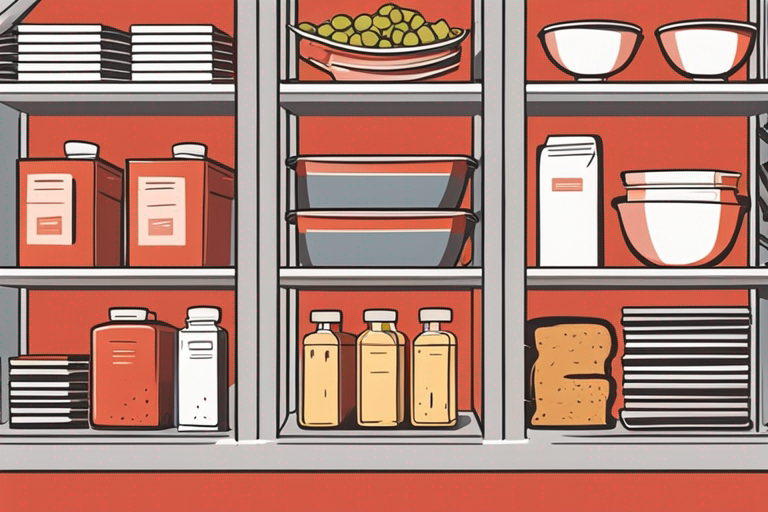
The Ultimate Guide to Emergency Food Boxes
Get Your Free Food Safety Cheat Sheet
30 most common foods with instant answers. Print it and stick it on your fridge—completely free!
The Ultimate Guide to Emergency Food Boxes
In times of emergency or natural disasters, having access to proper nutrition is crucial for survival. Emergency food boxes are pre-packaged food supplies designed to provide essential nutrients and calories during difficult situations when access to fresh food may be limited. In this comprehensive guide, we will explore the importance of emergency food boxes, what they typically contain, how to store them safely, and tips for choosing the right options for your needs.
Why Emergency Food Boxes Are Essential
During emergencies such as hurricanes, earthquakes, or power outages, having a supply of non-perishable food can be a lifesaver. Emergency food boxes offer several benefits, including:
1. Long Shelf Life
Emergency food boxes are specially designed to have a long shelf life, often ranging from 5 to 25 years depending on the type of packaging and food items included. This ensures that the food remains safe to eat even after extended periods of storage.
2. Nutritional Value
Most emergency food boxes contain a variety of nutritious foods such as dehydrated fruits and vegetables, protein sources, grains, and dairy products. These items are carefully selected to provide essential vitamins, minerals, and macronutrients to support overall health during emergencies.
3. Convenience
Having a supply of emergency food boxes on hand eliminates the need to rush to the store or rely on perishable items during a crisis. They are compact, portable, and easy to store, making them a convenient option for emergency preparedness.
4. Peace of Mind
Knowing that you have a stockpile of emergency food boxes gives you peace of mind in uncertain situations. It allows you to focus on other aspects of emergency planning without worrying about food shortages.
What to Look for in Emergency Food Boxes
When choosing emergency food boxes, there are several factors to consider to ensure you select the best option for your needs:
1. Caloric Content
Look for emergency food boxes that provide an adequate number of calories per day, typically around 1,500 to 2,000 calories. This ensures you are receiving enough energy to sustain yourself during an emergency.
2. Variety of Foods
Opt for emergency food boxes that offer a variety of food items to prevent flavor fatigue and ensure a well-rounded diet. Look for options that include fruits, vegetables, proteins, grains, and snacks.
3. Dietary Restrictions
If you have dietary restrictions or food allergies, choose emergency food boxes that cater to your specific needs. Many companies offer options for gluten-free, vegetarian, vegan, or dairy-free diets.
4. Packaging
Check the packaging of the emergency food boxes to ensure they are durable, airtight, and waterproof. Proper packaging helps protect the food from moisture, pests, and other contaminants, extending its shelf life.
Storing Emergency Food Boxes Safely
Proper storage is essential to maintain the quality and safety of emergency food boxes. Follow these tips to ensure your emergency food supply remains viable for an extended period:
1. Choose a Cool, Dry Location
Store emergency food boxes in a cool, dry place away from direct sunlight, moisture, and extreme temperatures. Ideal storage locations include a pantry, basement, or closet.
2. Rotate Stock Regularly
Check the expiration dates on your emergency food boxes and rotate the stock as needed to ensure you are always consuming the oldest items first. This helps prevent food waste and ensures you have a fresh supply on hand.
3. Monitor Temperature
Keep track of the temperature in the storage area to ensure it remains within the recommended range for the specific emergency food boxes you have purchased. Extreme heat or cold can affect the quality of the food.
4. Inspect for Damage
Regularly inspect the packaging of your emergency food boxes for any signs of damage, such as tears, punctures, or leaks. Damaged packaging can compromise the safety and shelf life of the food inside.
Conclusion
Emergency food boxes are a valuable resource for emergency preparedness, providing essential nutrition and peace of mind during challenging times. By selecting high-quality options, storing them properly, and following safety guidelines, you can ensure your emergency food supply remains effective and reliable when you need it most. Invest in your safety and well-being by adding emergency food boxes to your emergency preparedness plan today. Stay safe, stay prepared!

Authoritative Food Safety References
These agencies and university labs inform every tip and health precaution we publish.
USDA FoodKeeper – Cold Storage Guidelines
Official refrigerator, freezer, and pantry timelines maintained by the U.S. Department of Agriculture.
Visit USDA FoodKeeperFDA Produce Safety Rule & Grower Guidance
Field-to-fridge handling practices that prevent contamination of fruits, vegetables, and leafy greens.
Visit FDA Produce SafetyCDC Foodborne Illness Prevention Hub
Surveillance-backed guidance on pathogens, symptoms, and steps to reduce foodborne illness risk.
Visit CDC Food SafetyUC Davis Postharvest Technology Center
University research detailing optimal storage atmospheres for produce after harvest.
Visit UC Davis PostharvestPenn State Extension – Home Food Preservation & Safety
Peer-reviewed extension bulletins on safe canning, chilling, and reheating practices.
Visit Penn State ExtensionHow long do emergency food boxes last?
How should emergency food boxes be stored?
Are emergency food boxes safe to eat in case of a food allergy?
How can I donate or receive an emergency food box?
Get Your Free Food Safety Cheat Sheet
30 most common foods with instant answers. Print it and stick it on your fridge—completely free! Want more? Upgrade to the complete guide with 70+ foods.
Scan your food directly and get instant safety info using our AI-powered camera feature.